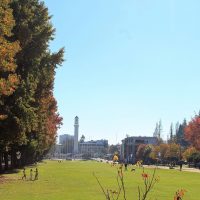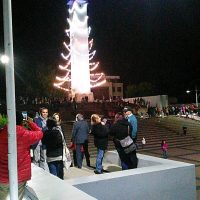Little more than a year ago, sat alone in Heathrow airport departure lounge, I felt that unnerving combination of excitement and dread. It was the same feeling I experienced when I started university, and when I travelled alone for the first time. This time round, it was a combination of the two! I was heading to Concepción in Chile to start my year abroad. It was just the second time that I had left Europe, I was not particularly confident in my ability to speak Spanish and, having already decided that I would not be coming back to the UK during the Christmas holidays, it would be the longest time I had ever spent away from home – that feeling was justified! In fact, it would surprise me if anyone waiting to go on their year abroad felt any differently. But as ever, the dread quickly faded away as I settled in and ‘Conce’ felt more and more like home, made easy by the welcoming and friendly nature of Chileans. Part of what made me nervous was the fact that I had no idea what to expect – everything I knew about Conce was from its Wikipedia page! So, instead of writing a typical blog about the highs and lows of a year abroad, I thought I would write a bit about my exchange university, la Universidad de Concepción (UdeC), Concepción as a city, and what you can expect from a placement there.
It’s safe to say that Conce is one of the further afield exchanges on offer at Southampton. Located 500km south of the capital, Santiago, it took me two 10-hour flights with a stopover in Toronto (admittedly not the most direct route on offer, but the best value at short notice) to get to Santiago, plus a 6-hour bus ride to arrive at my new city. As hellish as it sounds, the buses in Chile are surprisingly comfortable, especially considering the price, and they are the principle method of transport in the country.
I chose to stop over in Santiago to explore the city for a few days before bussing south, so my first impressions of Conce were constant comparisons to the capital. Originally, I had applied to study in Santiago, but in hindsight am very glad I was offered a place in Concepción instead. In contrast to the busy metropolis of Santiago, Conce is a lot smaller (as a rough guide I would say Santiago is like London whereas Conce is much closer in size to Southampton) and has a more relaxed atmosphere. Don’t get me wrong though, it is not a remote town, far from it in fact: Gran Concepción (Concepción and the nearby towns) is the second largestconurbation in Chile, so there is plenty of stuff to do. The city is divided into equal sized square blocks making it very easy to navigate, with streets typically named after key figures or battles in the Chilean battle for independence. The hub of the city, for students especially, is around the UdeC campus. There are no uni halls of residence in Chile, so most students live in pensiones or privately rented flats close to campus. It is one of the nicest areas of the city, with a modern shopping mall and el Parque Ecuador nearby, but the major attraction is Plaza Perú. This small plaza is buzzing with student presence: during the day, people are meeting with friends or queueing to buy lunch at the various cheap but great restaurants; as classes end, the cafes fill up to serve ‘once’, the Chilean equivalent to British afternoon tea – usually a tea or coffee with sweet pastry or an empanada; and in the evenings, people flock to the numerous bars around the plaza to relax with a piscola or michelada.
The uni campus itself is stunning. The large arch of the medicine block marks its grand entrance and a white clocktower stands over the forum in the centre of the campus. Flag poles proudly fly the Chilean flag on special occasions and national holidays in front of the lawn which leads up to the university central library with faculty buildings dotted around. The campus is always busy; it is a popular place for students to hang out. Just walking from one end to the other during term time you see students selling homemade chocolate truffles at stalls, groups dancing to reggaetón tunes, skateboarders and jugglers all within 20 metres, and others just chilling on the lawn. During exam time, you might even see some people going to the library to study!
As a Spanish and History student at Southampton, I chose to study history during my exchange. UdeC were particularly lenient about which modules I could study, so I was able to mix and match modules from different courses. I took three modules in total: Historia de Chile Siglo XIX, Historia Contemporánea and Geopolítica y Relaciones Interncaionales. The classes are obviously taught in Spanish, which was definitely a struggle at first, but did get easier and for me was a nice way of seeing my improvement, gradually understanding more and more each week.
The support network (OFIS) at the UdeC is also great. They were in touch before I left England to see if I needed any advice, a student met me when I arrived to show me around the city and help find me somewhere to live. During the term, they organised great events with other exchange students, including a trip to the nearby Nevadas de Chillán and days out at beautiful beaches.
On this note, I couldn’t write a blog post about a year abroad in Chile without mentioning one of its biggest benefits: travel opportunities. Chile is an amazing and diverse country, home to every landscape imaginable! Between the Atacama desert in the north and mountains and glaciers in Patagonia, one of the most southern places on Earth, you can find wine- and pisco- producing vineyards, ski resorts in the mountains, beautiful beaches, lakes and volcanoes. It is an incredible country! And if that isn’t enough, it’s only a short flight to neighbouring Argentina, Bolivia and Peru, so there is always somewhere new to visit.
I had an amazing time in Chile. I met some great people, learnt a lot about a new culture and explored a stunning country. I can’t recommend a Chilean year abroad enough!




